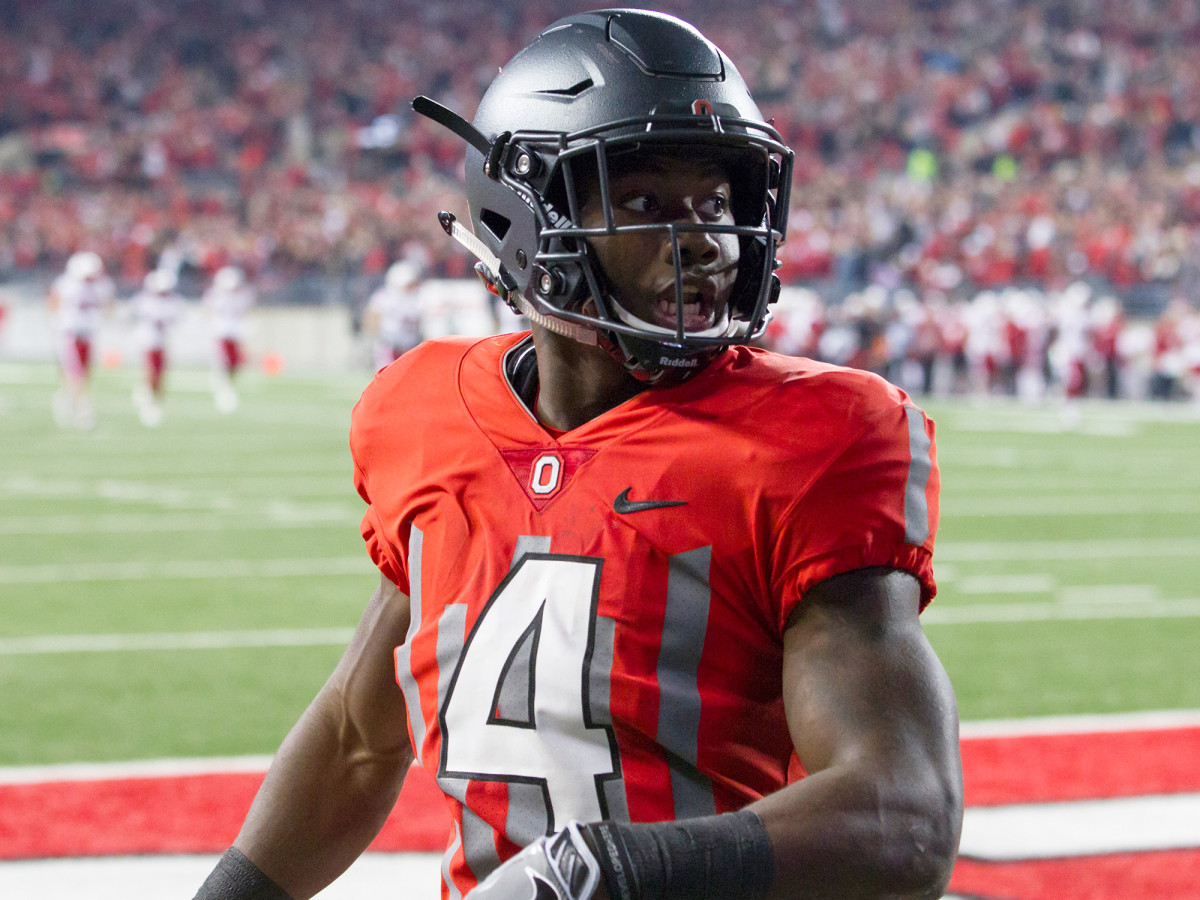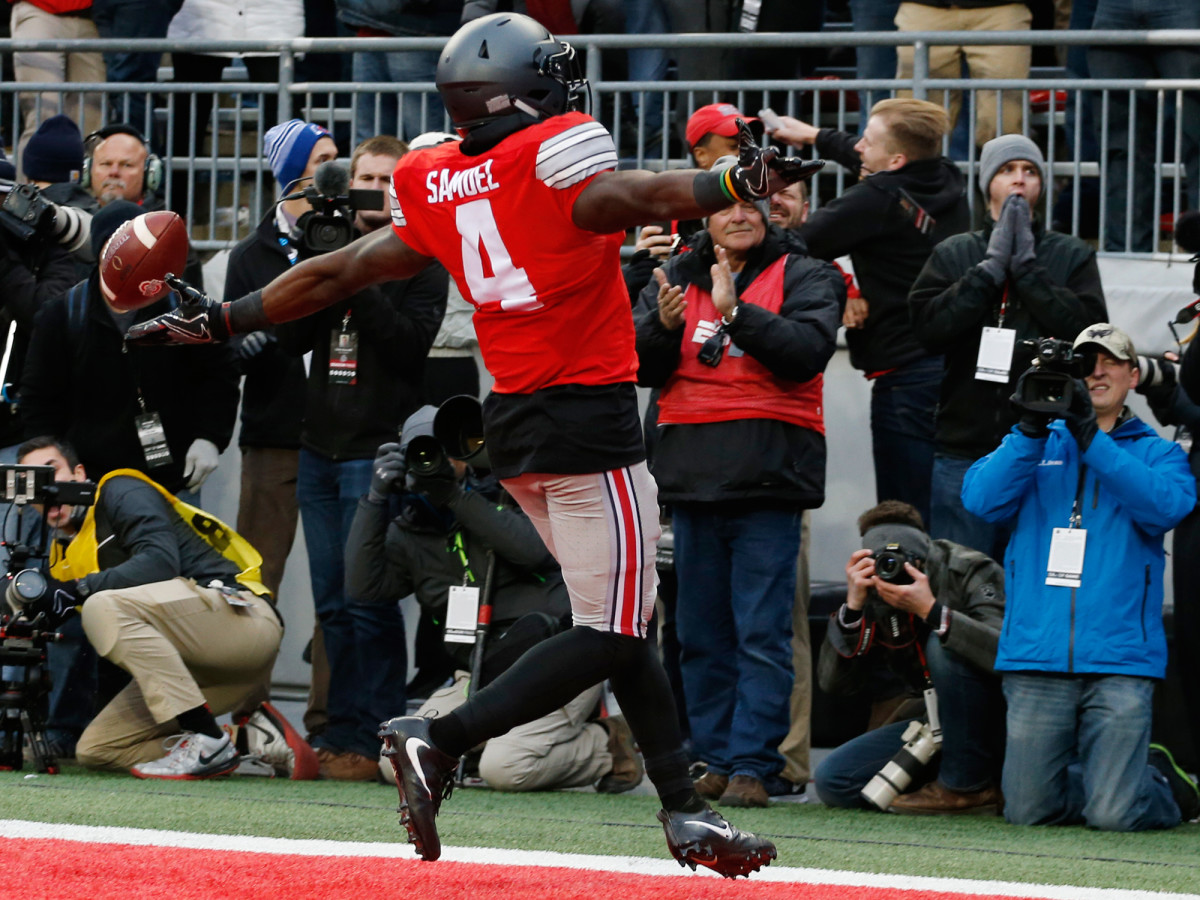Ohio State H-back Curtis Samuel is a star, but he's not finished yet

This story appears in the December 26, 2016, issue of Sports Illustrated. To subscribe, click here.
The address of Erasmus Hall High—911 Flatbush Avenue—contains a sense of urgency, but the place itself suggests permanence and achievement. The massive stone edifice across from the Benny Jewelry & Pawn Shop rises like a castle above Brooklyn's landscape. To enter, open the red door, walk through the metal detector and past the X-ray machine. One of the two guards there may offer a key to the bathroom, but only after a promise to lock it on the way out.
Steeped in history and layered in grit, Erasmus Hall has been connected to household names for centuries. No, really. Walk out to the courtyard and find one of the oldest standing buildings in New York City, which housed Erasmus Hall Academy in 1786. Long before Hamilton was a Broadway smash, Alexander Hamilton and Aaron Burr were key benefactors in opening the school. Over the decades, as the enrollment swelled to nearly 6,000 students, everyone from Al Davis to Barbra Streisand, Bobby Fischer to Neil Diamond, Jerry Reinsdorf to Shaggy (of reggae fame, not Scooby Doo) walked the halls.
A photograph of the school's newest star hangs outside the principal's office. Curtis Samuel is not a chess savant or an NFL owner or a chart topper. But in his first season as a full-time starter, the Ohio State junior H-back became the most electric player in the Big Ten, joining his Erasmus predecessors in his ability to command the stage.
Who will win the College Football Playoff? Making the case for each team
The oversized photo captures Samuel seconds after his 15-yard touchdown run beat Michigan 30–27 in double overtime on Nov. 26. His arms are outstretched in celebration, not just of the win, which secured the Buckeyes' spot in the College Football Playoff, but also of the moment he arrived as a college football star, ushering his Brooklyn roots to the forefront. New York City doesn't produce much in the way of gridiron talent; only one player has made the top 50 of the 247 Sports composite recruiting rankings since 2011 (offensive tackle Isaiah Wilson of Brooklyn's Poly Prep in 2017). Samuel inspires reconsideration.
His rise began in the 6th Walk of the Kingsborough Houses, a project in the Crown Heights section. He sliced through the PSAL so swiftly that one YouTube commenter accused Erasmus coach Danny Landberg of speeding up Samuel's game film. The Dutchmen won a city title in his junior year, in 2012, and the Buckeyes grabbed a national championship in his freshman year. This season Samuel earned first-team All-America honors as an all-purpose player. If he returns to Ohio State as a senior, he'd have a chance to become New York City's first Heisman Trophy winner since Brooklyn's Vinny Testaverde in 1986—10 years before Samuel was born.
When he arrived in Columbus, Samuel's Brooklyn accent was so pronounced his teammates teased him for saying gahed instead of go ahead and pursh instead of push. But his role as Ohio State's most dynamic player is simple to understand. These Buckeyes have a finer margin for error than the championship team of 2014, which boasted a powerful offensive line and a corps of playmaking receivers. A winning game plan now needs its own Brooklyn accent: To topple No. 2 Clemson in the Fiesta Bowl on Dec. 31, No. 3 OSU is going to have to gahed and pursh the rock Samuel's way. "I don't think," coach Urban Meyer says, "we can win without him."

Curtis Samuel can trace his path to Ohio State back to Atlantic City sometime after the 2003 football season. That's when Landberg borrowed his mother's Lexus to haul down the Garden State Parkway to the Tropicana Hotel, where a young Urban Meyer was speaking at a clinic for high school coaches. Meyer had just gone 10–2 at Utah with an unsung quarterback named Alex Smith and a spread offense that incorporated shovel passes, jet sweeps and the read-option. Landberg had been so intrigued by the innovative system that he'd bought a grainy VHS tape of Utah for $100 off eBay, and that night he scribbled notes furiously as Meyer spoke.
More than a decade later Landberg walked into that office while accompanying Samuel on a recruiting trip and made a demand of the Ohio State honcho: "You owe me money." Meyer looked baffled, and Landberg quickly explained that Meyer's Utes had failed to cover a bet that cost Landberg a few bucks.
A mutual admiration circuit formed. Landberg knew long before he walked into Meyer's office that he wanted Samuel to play for Meyer, even paying out of his pocket for multiple trips to Columbus, once with and several times without Samuel. Samuel even jokes about his high school coach's obsession with Meyer: "He has an issue."
As for Samuel, he grew up idolizing one of Meyer's stars at Florida, Percy Harvin, calling up his highlights on YouTube and modeling his game after the part-time receiver, part-time tailback and full-time menace. Meyer had been searching for a player with similar burst and versatility since Harvin declared for the NFL in 2009. The staff saw Samuel and knew it had their man. "Watching his game tape," says receivers coach Zach Smith, "was like watching a highlight tape."
The breakaway display was nothing new. Samuel began walking at seven months, and even then it was hard to keep up with him. There was Curtis doing flips off the wall, jumping off the gate, dominating games of tag in Kingsborough. Finally, when he was nine, Samuel's godmother, Francine Harris, took him to play football. Brooklyn Saints coach Roy Armstead found more than a star player. After one practice he met Samuel's mother, Nicole, who had split with his father, Curtis Council, an aviation manufacturing worker who now lives in Virginia. Nicole and Armstead have been dating for 11 years, and they're engaged to be married next year. Samuel calls Armstead his stepfather.
From the Saints, Samuel made a smooth transition to Erasmus Hall. His first carry with the varsity came as a sophomore, when he burst across the backfield on a jet sweep, fumbled, casually picked the ball up and ran 60 yards for a touchdown. "That was legendary," says Armstead. "If you didn't know Curtis Samuel [before], you knew him then." Samuel kept on running, averaging 15.8 yards per carry his senior year, when he scored 17 touchdowns. He complemented his production with elite testing, ripping off a 4.37 40-yard dash, to become a rare bona fide New York City prospect. The recruiting gurus remained skeptical, largely because of geography. Had he been from Florida, Samuel might have been a top 25 prospect, but hauling the city behind him, he ranked No. 59 in the 247 composite.
The July before his senior year at Erasmus Hall, Samuel visited Ohio State with Landberg for its Friday Night Lights recruiting event. Meyer had long been sold on Samuel's film—"It was like magic every time he touched the ball"—and Landberg could only smile when Samuel committed on the spot. "We didn't even have a discussion," Landberg said. "I don't know how you want to say it. Predestined is a good word."

On a third-and-nine from the 24-yard line during the second overtime against Michigan, Samuel took a swing pass from quarterback J.T. Barrett at the 29, pinballed around, reversing field three times and covering about 70 yards from one sideline to the other, before cutting upfield to gain eight. Along the way Samuel ran nearly 10 yards backward, far enough to potentially create a fourth-and-very-long and push Ohio State out of field goal range. Instead, his improvisation provided one of the most entertaining and important plays of the season. After Barrett converted on fourth down, Samuel raced in for the winning score. "I'm really glad Curtis Samuel is a Buckeye," Barrett recalls thinking afterward.
Clemson defensive coordinator Brent Venables has a much different feeling as he studies game film for his matchup with the Buckeyes. As Oklahoma's DC he had to prep for USC tailback Reggie Bush and then for Harvin before BCS title games. In his early study on Samuel he sees the same rare ability. "It looks like he may possess the best traits of both those guys," Venables says. "He can go from zero to 60 in about two seconds."
At 5'11" and 197 pounds, Samuel is powerful enough to run between the tackles (7.7 yards per carry) yet elusive enough to line up in the slot and elude a nickel corner (12.6 yards per catch). Buckeyes strength coach Mickey Marotti, who worked under Meyer at Florida, says Samuel's freaky testing numbers—37-inch vertical, 10'6" broad jump, 500-pound squat, 400-pound bench press—are comparable to Harvin's.
Teams are so consumed with stopping Samuel that Michigan State co-defensive coordinator Harlon Barnett nicknamed him Waldo. Before every snap the Spartans were required to ask, "Where's Waldo?" Run a nickel package to shadow Samuel with a defensive back, and Ohio State will use a power-run game to exploit the dearth of defenders in the box. Use an extra linebacker to slow the run, and Samuel will motion out to the slot, drawing that suddenly overmatched linebacker with him. "Couple the mismatches with his athleticism," says Oklahoma assistant defensive coordinator Kerry Cooks, "and he's a nightmare."
The case against eight: Why College Football Playoff should stay at four teams
Samuel is also a great decoy. After he ran for 18 yards on the first play of overtime against the Wolverines, Ohio State sent him in motion. Barrett watched three defenders follow, then simply kept the ball, waltzing seven yards for a touchdown. "He ran a flare route, and I peeked at him," Barrett says. "And it parted the Red Sea."
Samuel sits on a silver bench in the Buckeyes' indoor practice facility on a recent Wednesday afternoon. He breaks into a smile when talking about his favorite topic—roasting. Samuel's wit is as quick as his first step, with those closest to him the most frequent targets. He busts on Meyer for his penchant for awkward handshakes, consistently sticking out two fingers as a greeting, expecting a two-finger tap in return. "If there is a stand-up comedian on our team," says Marotti, "it's him."
The jokes are willingly reciprocated. Sophomore receiver Terry McLaurin recalls Samuel shaving his head recently, which accentuated the size of his nose. "We'd say he could smell what his mom was cooking back in Brooklyn," says McLaurin. "He didn't like that too much. He started growing his hair out."
Sometime in January, Samuel will decide if he wants to keep cracking up the Buckeyes or try cracking into the NFL. One scout says that he would be a top 60 pick if he comes out this year, but Samuel, a financial services major, isn't eager to leave. Refining his receiving skills—beating press coverage and playing more on the outside—could bolster his stock, and both Landberg and Armstead want him to return to Columbus, if only to make a run at the Heisman. "It's definitely tempting and interesting," says Samuel. "Especially with [the ceremony] being in New York."
Whether Samuel bolts or stays could be determined by his performance in the playoff. Regardless, his breakout 2016 season has thrust him into the conversation as one of the brightest stars, not just among football players but among Erasmus Hall alums. And his run has just begun.
